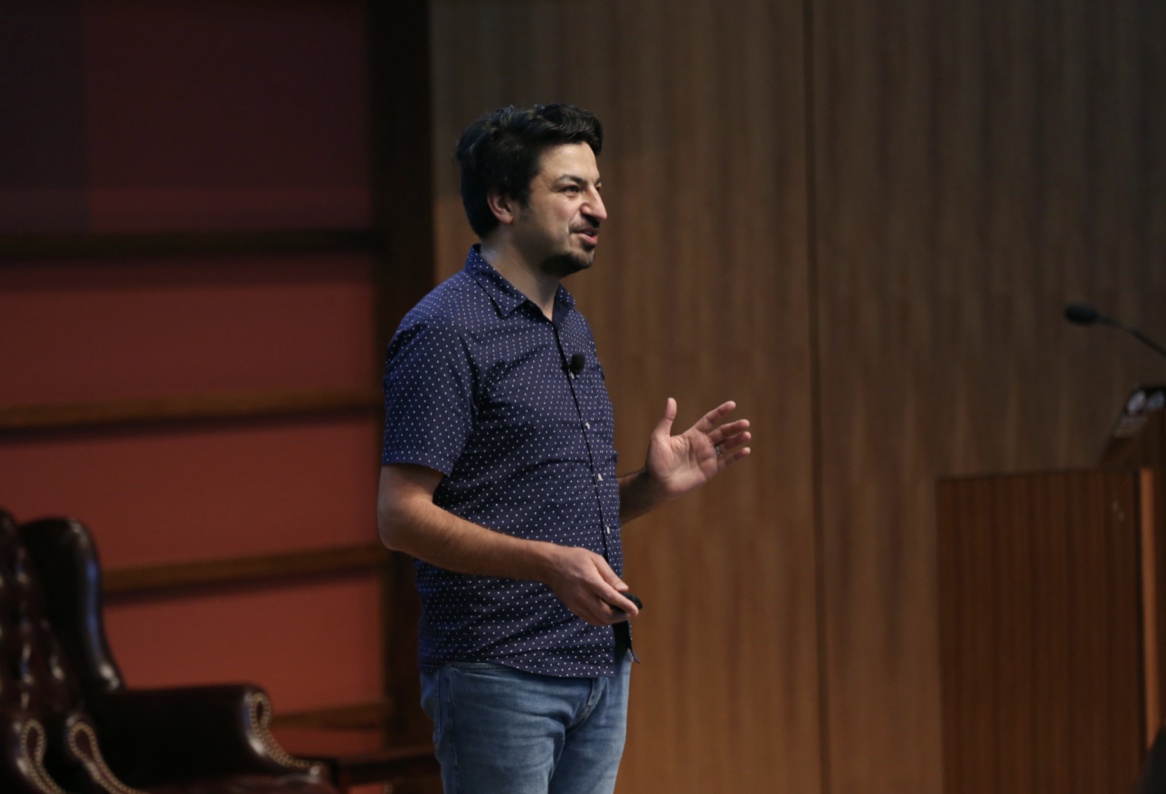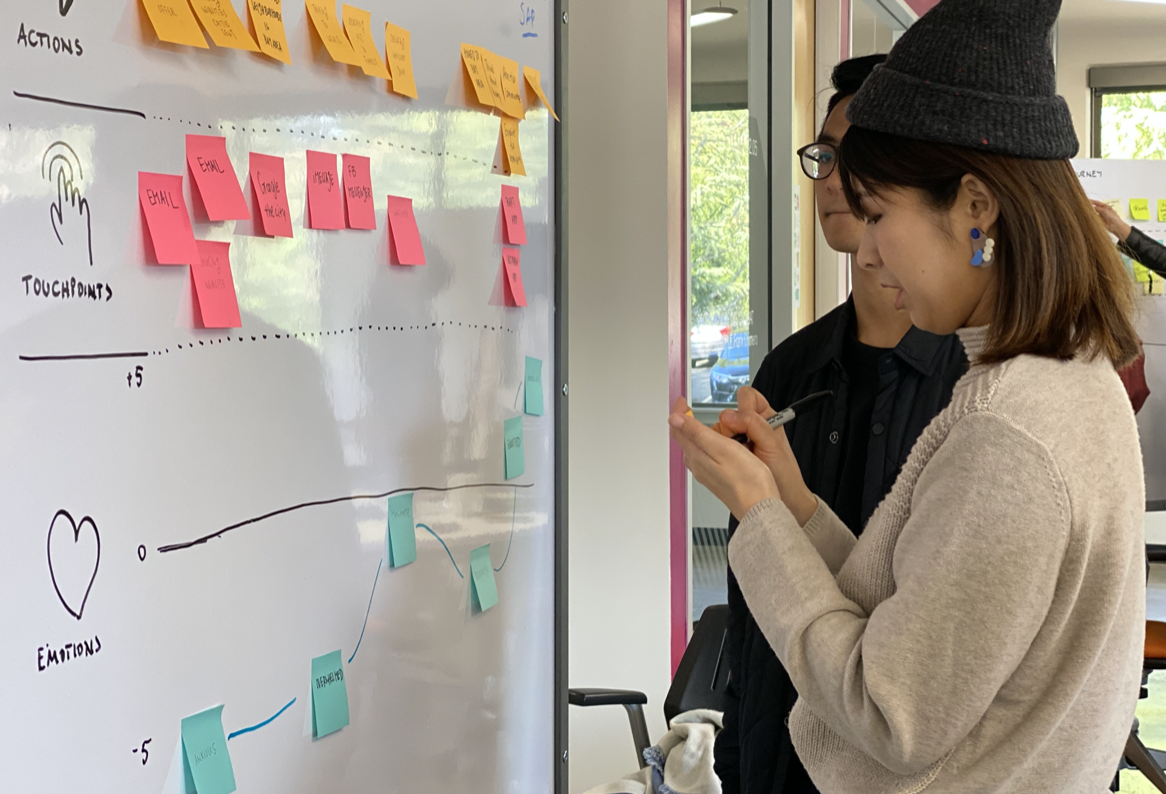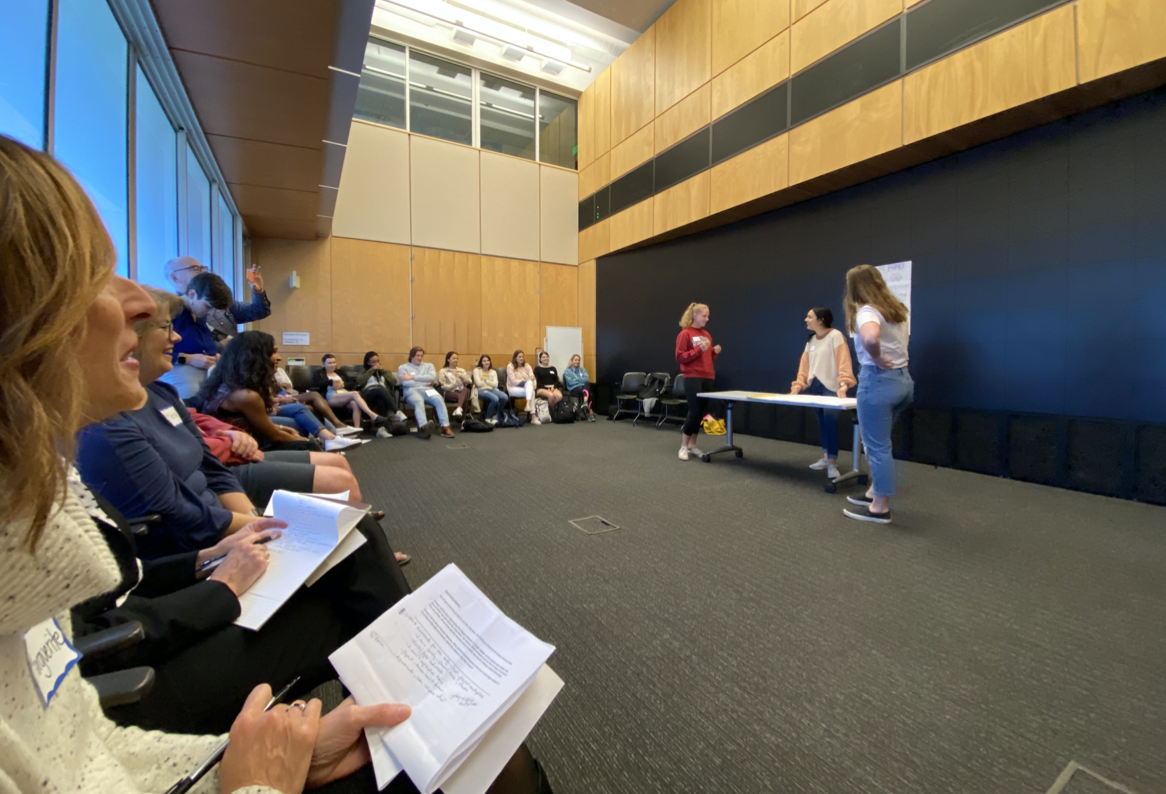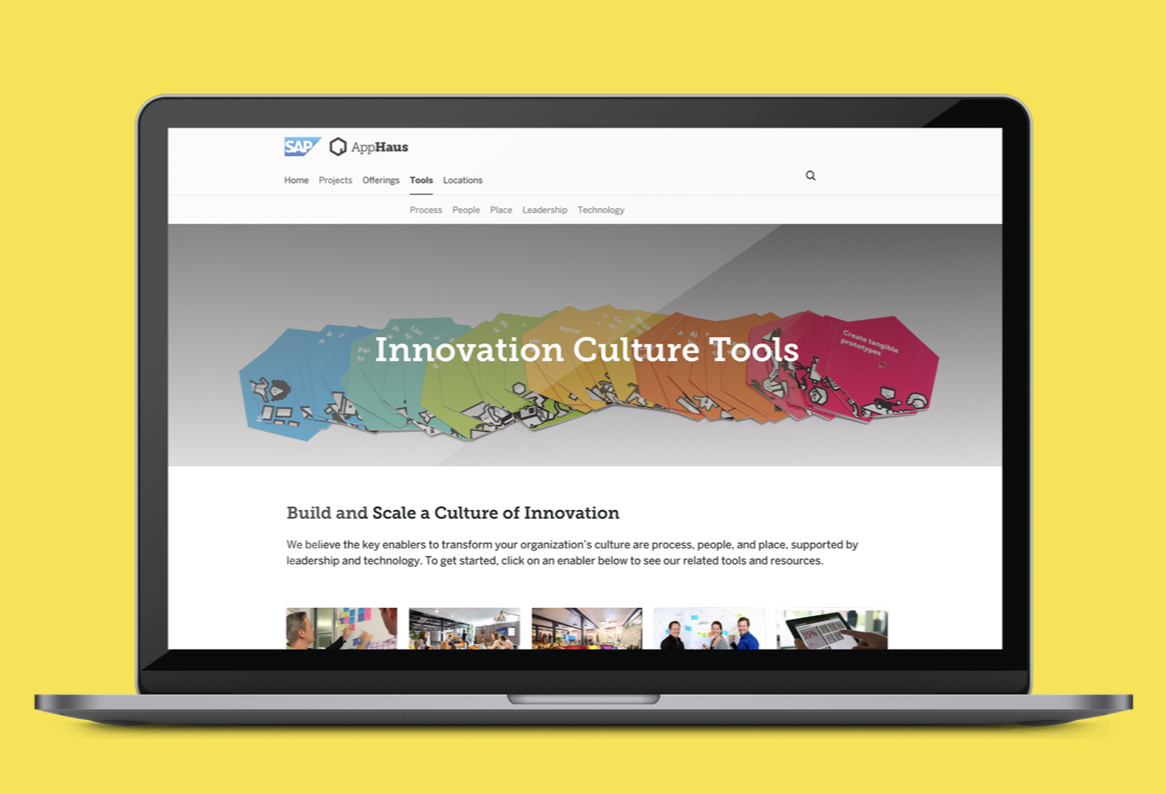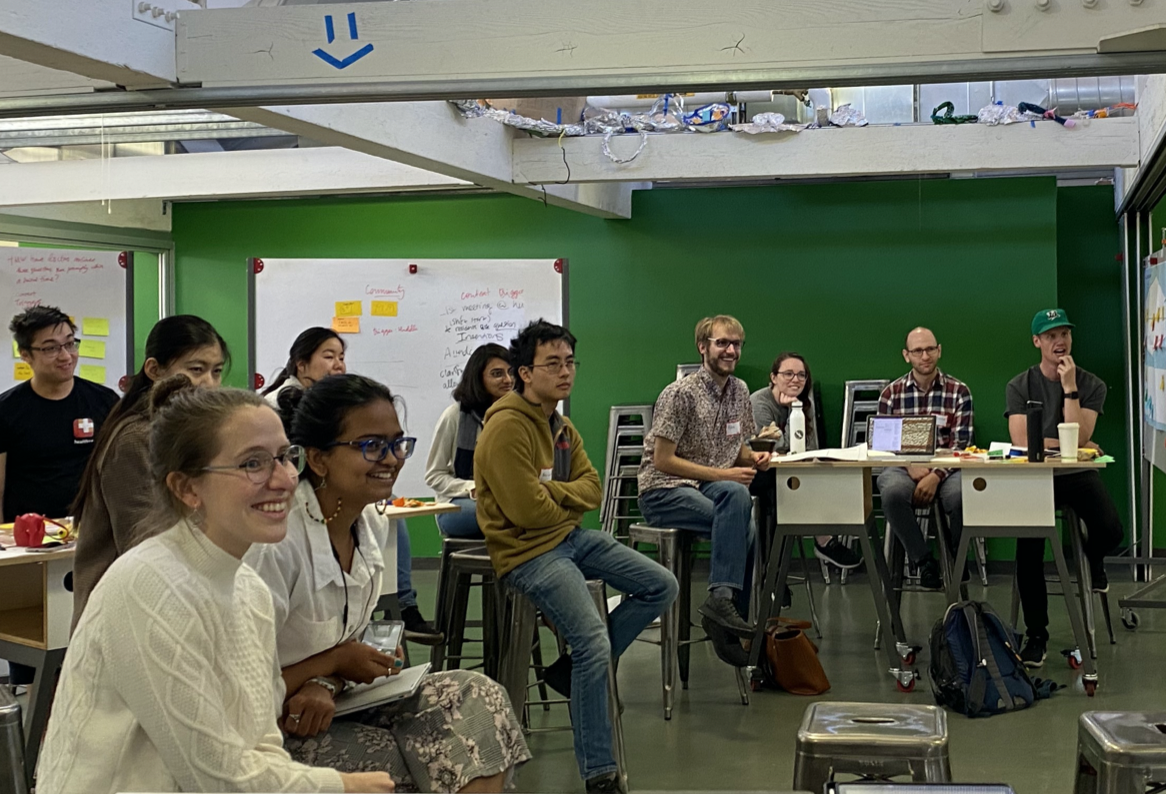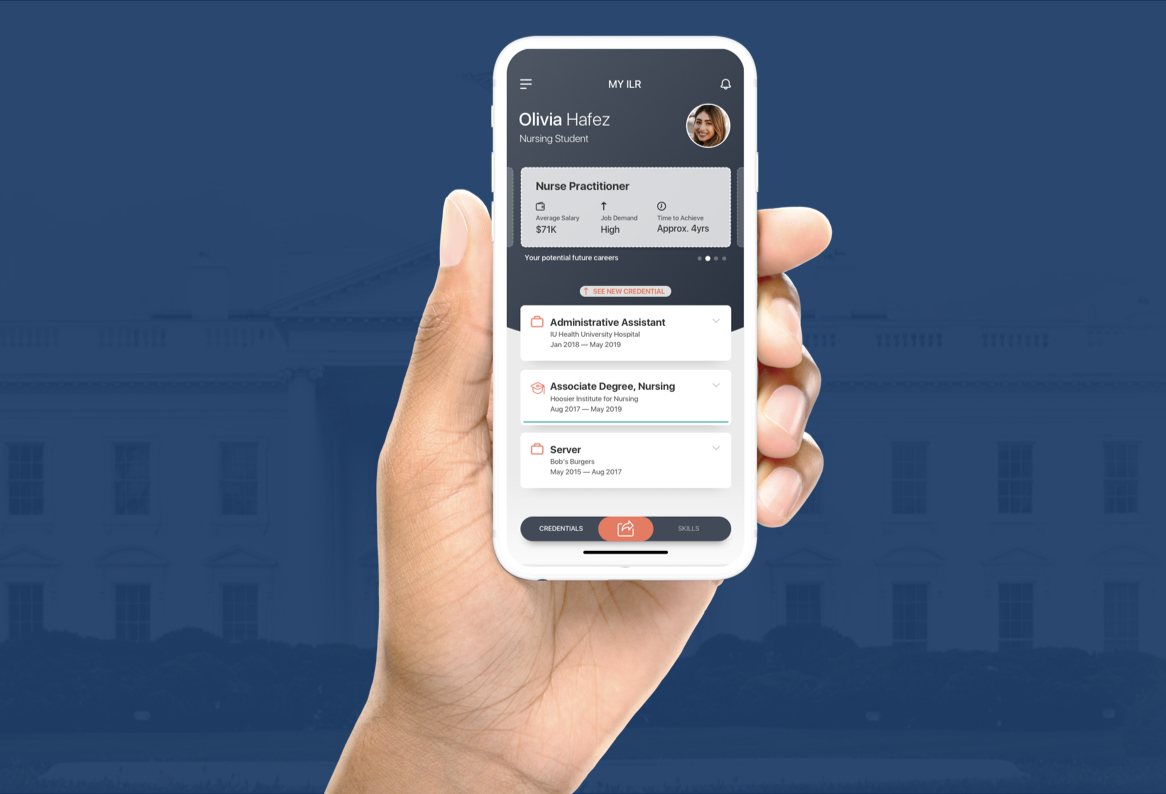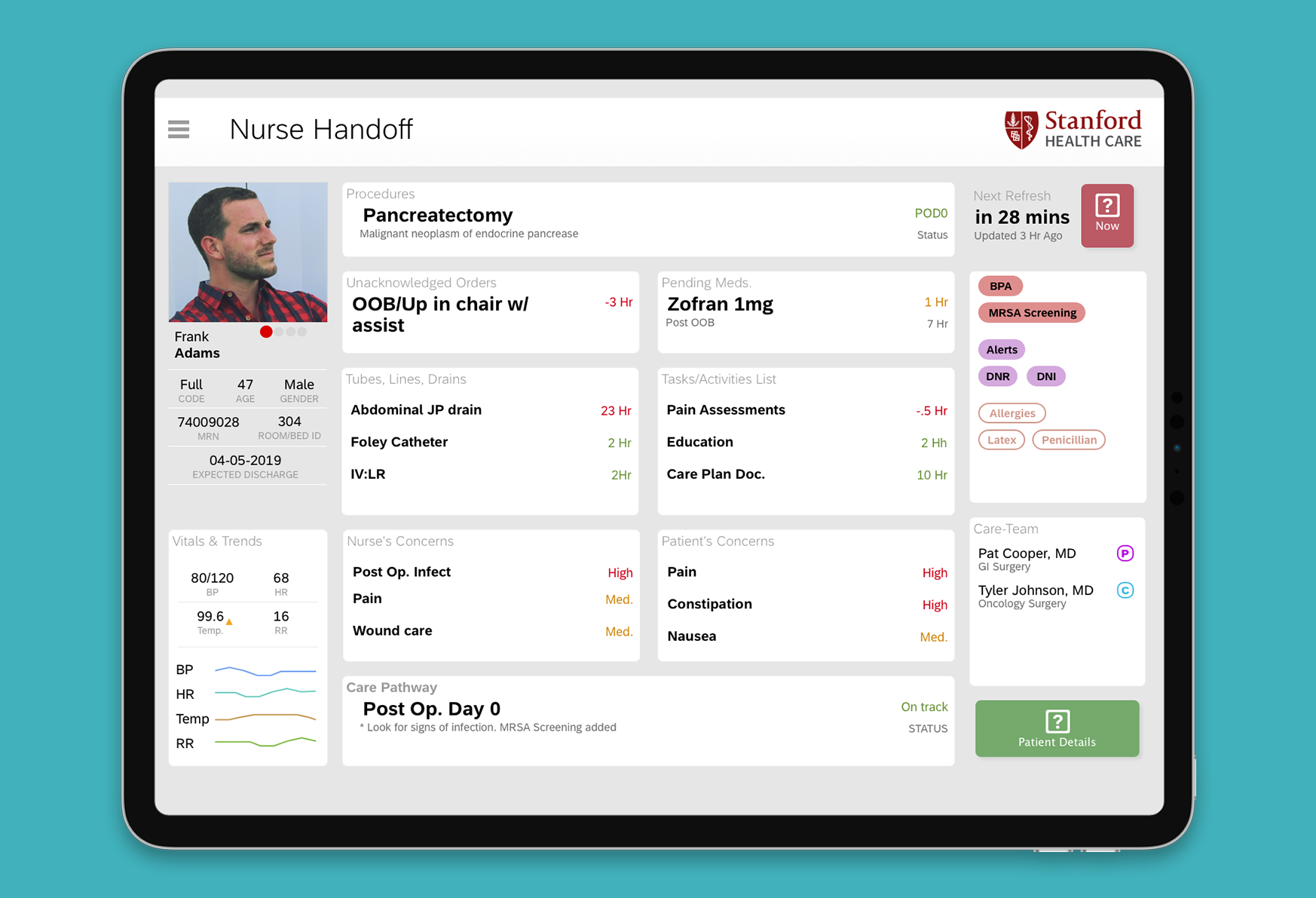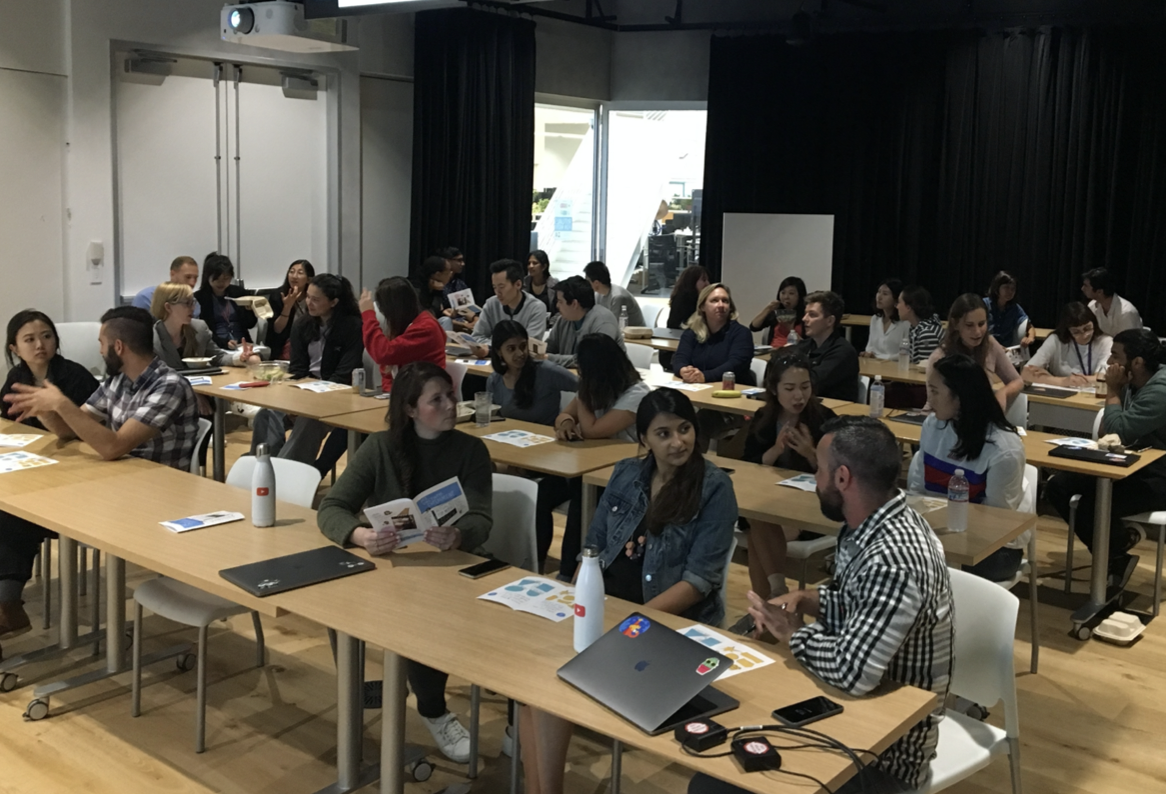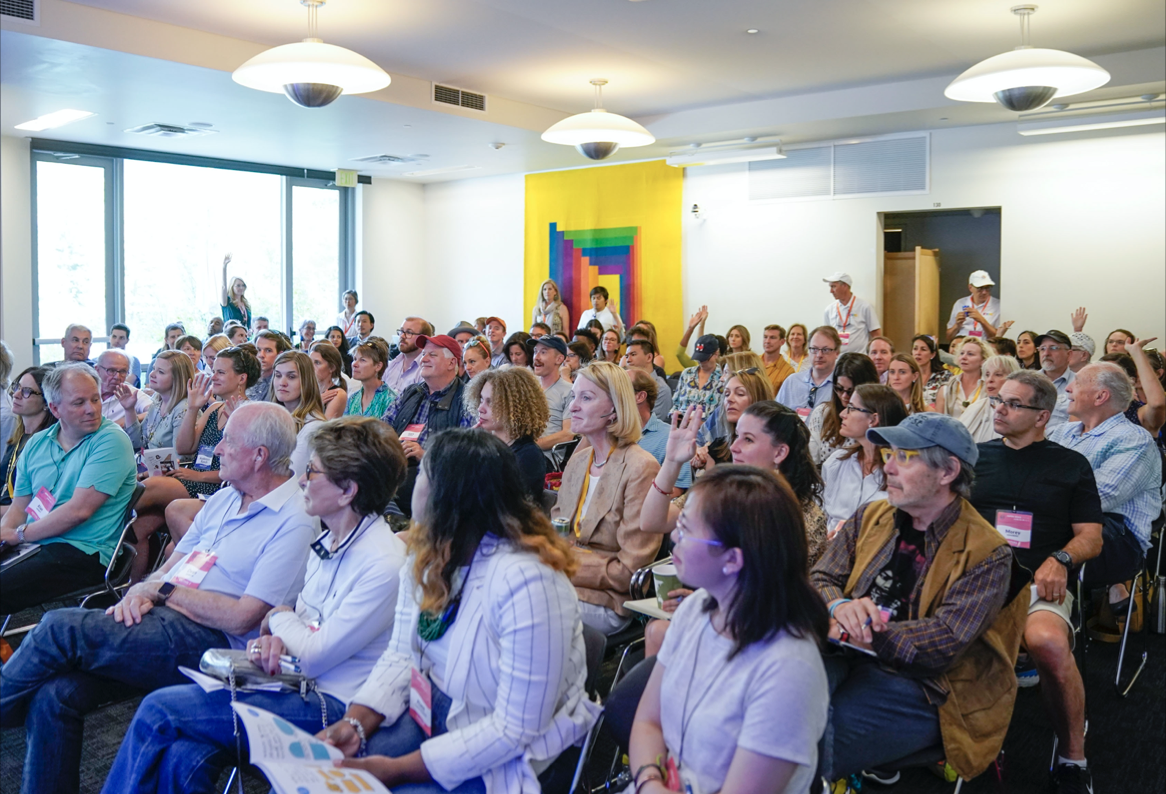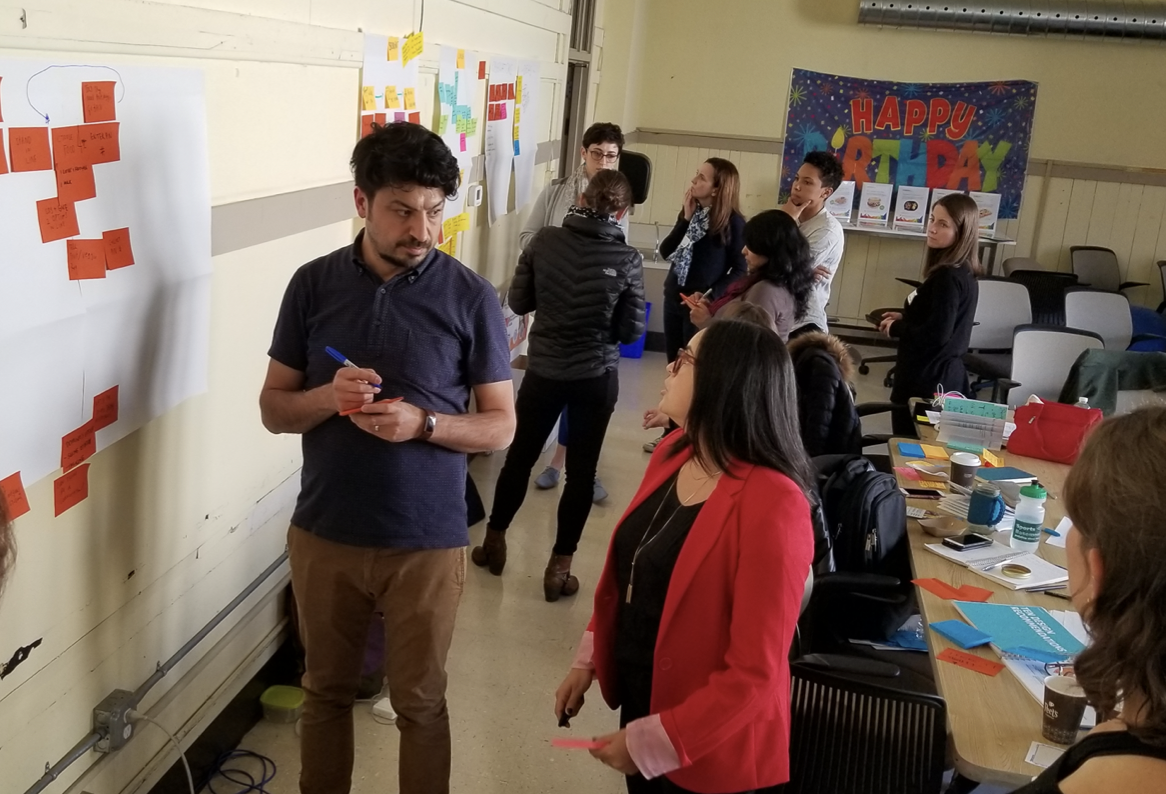Courses
Take Charge: Design Your Workplace Culture
In the Alumni Homecoming weekend, I gave a lecture on workplace culture. Rituals are powerful tools for building a culture that better aligns your values and priorities with your everyday practices. Our work shows how rituals help people bridge transitions, get to flow, deal with conflict, and increase bonding. In this session, we’ll share some of the insights from our work, and scope out some culture experiments to run — harnessing the patterns of rituals to think about lightweight, bottom-up ways to build better ways of meaning-making.
Silicon Valley New Talent Design Sprint
In January 2020, we led a design sprint session for the SAP Lab’s Silicon Valley Next Talent program. The goal of the design sprint is to upskill newly hired SAP designers to learn design thinking by doing.
We gave them a relatable design challenge: How might we improve new employee’s onboarding experience? They interviewed each other and created journey maps. Then they picked pain points and opportunity points from their journey maps and create design concepts. At the end of the design workshop, they presented their concepts by enacting them.
Leading Org Change Guest Lecture
In Winter 2020 semester, I ran a ritual design session in Bob Sutton’s Leading Organizational Change class! Students and our partners from Stanford HR were game from the get-go. They created corona-virus friendly greeting rituals, which involved lots of foot-shakes. Later on, they designed rituals that took the boring virtual meetings into totally new directions. Bob just wrote a quick piece about the class: https://www.linkedin.com/pulse/leading-organizational-change-15-things-i-believe-now-bob-sutton/
Protected: Innovation Culture Toolkit
Designing Well-being Rituals for Stanford ER Teams
On February 20-22, 2020, Ted Matthews, Kajal Khanna and I led a Stanford d.school class on Ritual Design for Better Workplaces. It’s a continuation of our other ritual design work and research, done within our Ritual Design Lab.
Ritual Design Lab has run many iterations of workplace ritual design workshops with partner organizations including Microsoft, Airbnb, SAP Labs, OneTable, and Norwegian Football Association, and now we shifted our focus on the challenges of burn-out in the workplace.
The class was a 3-day partnership with Kajal Khanna, an Assistant Professor in the Department of Emergency Medicine at Stanford University focused on physician well-being; and Assoc. Professor Ted Matthews, who is the Chair of Service Design at Oslo School of Architecture & Design and who’s research focuses on the potential of ritual for service design.
Can we design rituals to help emergency room employees improve their well-being in nimble yet effective ways?
Background on the challenge
The numbers around healthcare professionals’ well-being are alarming. 50 percent of doctors and nurses experience symptoms of burnout. The symptoms can include exhaustion, cynicism, and perception of inefficacy. The factors for burn-out are several, including work overload, pressure from various healthcare stakeholders(hospital admins, peers, insurance companies, patients), and stress. What are some of the ramifications of burn-out? Doctors and nurses who experience burnout are twice more likely to quit their jobs and even the medical profession. Female physicians are 250–400% more likely to commit suicide than other female professionals.
There’s a growing concern among physicians that objects to the narrative around individuals’ ‘burnout’ without addressing the bigger challenges. Simon Talbot and Wendy Dean suggest the concept of ‘moral injury’ instead. Moral injury happens when physicians’ and nurses’ values do not match the realities of everyday healthcare practice. And these may be related to systemic and structural challenges in the healthcare system.
Tackling systemic and structural challenges would require alignment from a wide array of healthcare system stakeholders and a longer engagement with the emergency room practitioners. Given our constraints, we decided to keep our scope tight, focused on daily interactions and relationships.
Discovery & Insights
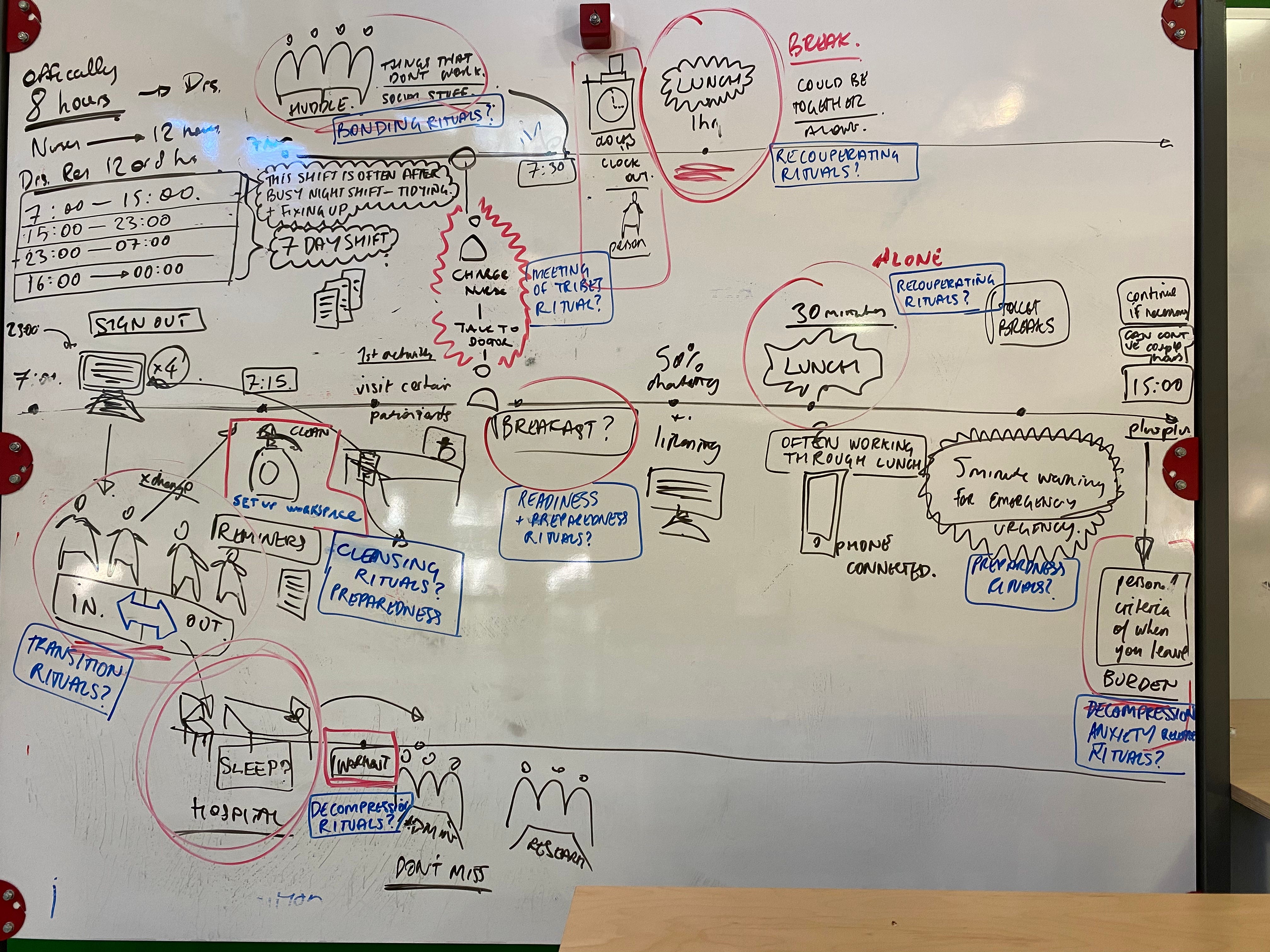
We did several interviews prior to and during the class and discovered several insights on the current experience threads among the care team members.
- In the emergency room, every day can be quite different. This makes routines highly vulnerable. For instance, the team in charge usually gets a 5-minute warning when an ambulance is on its way. The people in the shift can be quite different too. There are residents on rotation, nurses who are only temporarily working with the department and consultants who visit as needed.
- As we map the day-in-the-life of physicians and nurses, we discovered that shift changes, hand-offs, and other transition moments cause anxiety and emotional distress.
- Daily interactions can feel a bit mechanical. There’s an ongoing pressure to maximize time and complete the charting (adding patient data on the system.) This in return decreases the quality time interactions between members of the team and between the team members and the patients. This is supported by data.
- There’s a strong warrior mindset among healthcare professionals. They get through the hardships and long hours, because they are educated in that way, and can stretch themselves even though it drains them in the long run.
- People are bonded by the nature of the work — namely helping people in their healing journey. This bond is interrupted by time pressure and communication challenges. This poses challenges around psychological safety.
5 Well-being Rituals
Students formed teams and created 5 rituals by leveraging the insights from their discovery. They developed their concepts using ritual canvases that borrow ideas from ritual studies. For example, students craft their rituals by creating a trigger moment, intention, and ritual flow. They articulate their ritual concepts by thinking of emotional payoff, symbols, and a ritual arc. They then drew storyboards and acted out their rituals for feedback and refinement. In the end, they created ritual video sketches for the final show. Here are their rituals:
Blitz Ritual for Psychological Safety

When residents are part of the team, there is an untold anxiety among them: “Should I already know this question? Am I a bad resident for not-knowing this?” To overcome this anxiety, the team created a post-huddle ritual. The questions can be related to anything. Questions about medical knowledge that’s usually taken granted by the senior doctors are more helpful.
Ed-Blitz Ritual Flow
- Residents and anyone in the team can write questions anonymously on post-its and add to the Ed-Blitz question board.
- When there is enough volume of questions, the senior physician and residents get together and answer questions on the post-its.
- Board has two sections. The first section is questions for the attending doctor. The second section is open mic — whoever knows the answer can take the lead.
- Once they answer the question, they wrinkle the post-it and shoot a basketball.
- When the board is empty, the attending doctor gives more post-its to the group to encourage more questions.
- When the basket is full, residents take them to the recycling together to mark the moment.
Chime in Ritual for Living by Your Values
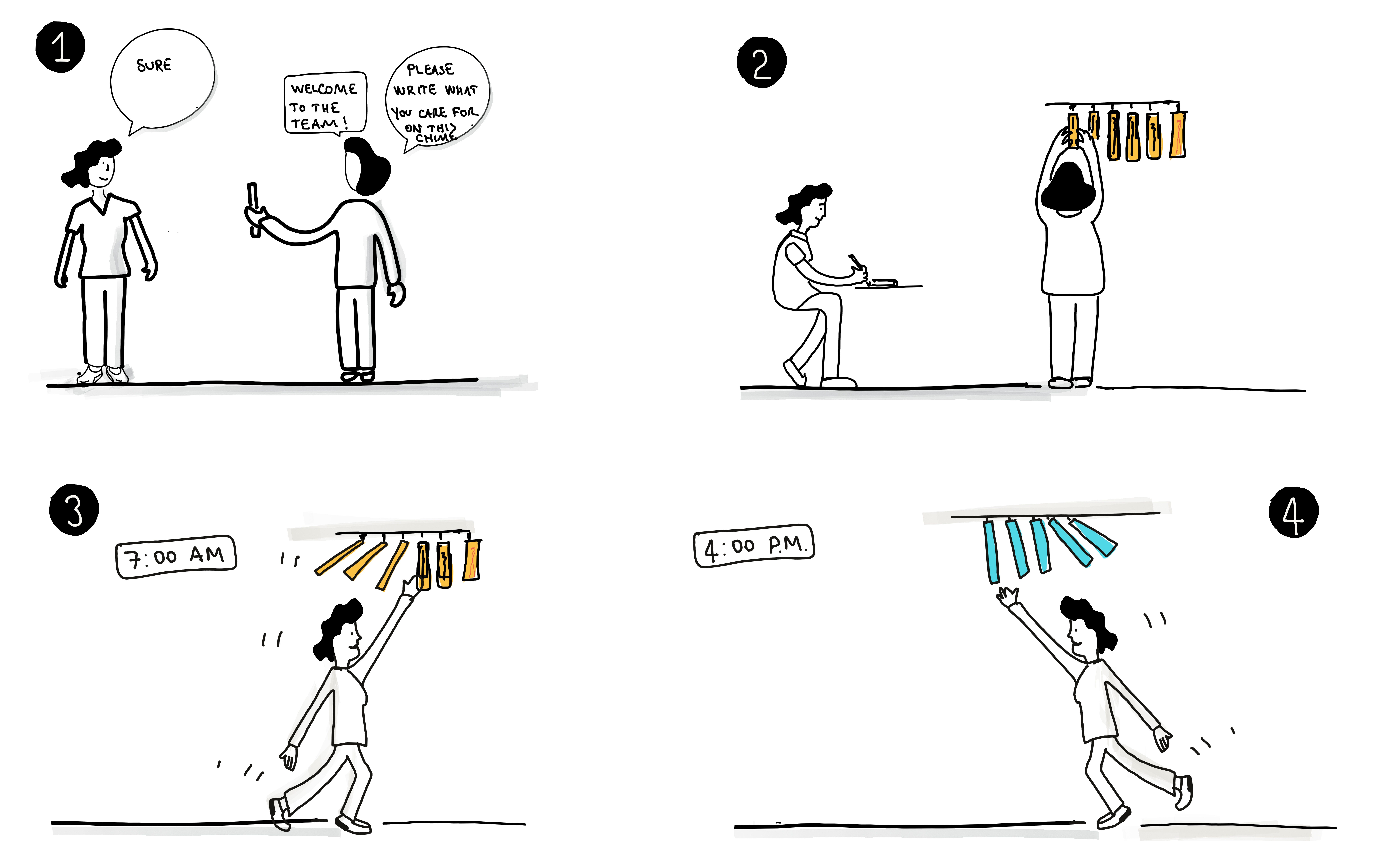
In the daily grind of work, it’s easy to become a cog in the machine and forget why you do what you do. This team created the Chime-in ritual with the intention to remind people of their values while they are beginning and finishing their shifts. They prototyped a chime with wrenches and elaborated on how-to onboard people to the ritual.
Ritual Flow
- When a new employee joins, they write their values on a chime tube and add to the team’s chime. And they are ready to chime in the next day.
- When they begin their shift, they check in with their card and chime in with a high pitch.
- When they leave their shift, they check out with the low pitch chime. It’s optional to chime in every day, however, it’s encouraged so that the individuals can signal that they are present.
That’s a Wrap Ritual for Anxiety & Shame

During the shift changes, two things happen. The physical environment gets quite messy after long hours of intense work. And the to-dos and patient workload spills over to the next shift. This usually triggers the feeling of shame for the off-going physician, and anxiety of workload for the incoming ones. To overcome these entangled emotions, this team created the That’s a Wrap ritual.
Ritual Flow
- The physician who is about to leave the shift welcomes the incoming doctors.
- They clean up space together, go through the patients’ to-dos.
- Then they mark the moment of hand-off by saying “That’s a Wrap!”
- The shift owners farewell the leaving physicians by banging the “Refresher buzz”
- Everyone claps the leaving physicians on way out. The new shift officially begins.
The Heroes Ritual For Recognition

Busy, loud and unfamiliar emergency rooms can be anxiety-inducing environments for children. Establishing a patient-doctor relationship is crucial but sometimes difficult in these environments. This team addresses this challenge with the intention to level the power dynamics between the two.
Ritual Flow
- The Heroes ritual starts with the doctor welcoming the child patient and offering hero stickers to pick from.
- Once the child picks the sticker, they celebrate it with a gesture from the hero and go about the treatment.
- After the patient-encounter, the doctor brings in more stickers, which are the medals of achievement.
- This time, the child picks a medal and puts the medal on the doctor’s scrub.
- This two-way sharing helps both the kid and the doctor feel they are mutually recognized.
The It’s-All-Yours Ritual

Shifts are long and tiring. Close to the end, when the incoming doctor comes in, the off-going doctor is busy with charting on a computer. Their interaction oftentimes feels mechanical. It happens by looking at a screen together, one person sitting in front, the other looking over the shoulder. To address this challenge, the team created a ritual to encourage face-to-face interaction and expressing gratitude.
Ritual Flow
- When the incoming doctor enters the space, they greet each other and get together around a circle facing each other.
- They talk about each patient’s status, pointing out the big monitor. Part of the monitor shows the messages from patients and the overall achievements of the past shift.
- The incoming doctor recognizes the achievements of the shift (patients covered, comments received)and celebrates with her peers.
- When they are done going over patients’ status, she asks “Can I take the board now?” The leaving doctor shouts “It’s all yours!”
- Then they tap their hands together on the table and mark the shift-change.
3 Learnings from Well-being Rituals
Reflecting back, we discovered several learnings from the rituals that students designed and the conversations we had.
Learning 1: Rituals can address burnout by managing relationships
The well-being rituals designed by our teams are mostly about managing relationships. Intentions vary from creating psychological safety to leveling power dynamics between people. Teams designed ritual flows to build and rejuvenate interpersonal relationships. That’s-A-Wrap and It’s-All-Yours rituals, for instance, help team members to recognize the tensions and overcome them with more face-to-face open interactions. This increase in positive interactions in return potentially could address the symptoms of burnout such as exhaustion, cynicism, and stress.
Learning 2: Rituals can alleviate anxiety and distress by channeling emotional energy
The other pattern that we observed is the channeling of emotional energy. There’s past research showing that rituals help regulate emotions. It’s even more relevant in the workplace where the emotions can get in the way of well-being. The It’s-All-Yours ritual, for instance, helps the team members to process the emotions together and release the emotional energy through symbolic phrases and acts.
Learning 3: Transition moments are critical for shifting culture towards well-being
As we mapped the day-in-the-life of emergency room employees, we discovered that transition moments such as shift-change and hand-off define the tone of the experience on that day for the person and the team. Addressing those moments has the potential to shift the culture towards more well-being in the workplace. The Blitz ritual, for instance, gives a chance for the person to reset if the shift is tough and emotionally difficult.
This is a piece recently published at d.school’s Medium publication.
Protected: White House ILR
Protected: Stanford Relay
Youtube Talk
2019 Aspen Ideas Festival Talk
I was one of the speakers at the 2019 Aspen Ideas Festival with Margaret Hagan. We turned the one-hour session into a mini-design workshop and explored the world of meaning-making with the audience. Below you will find our abstract and the interview that I’ve given prior to the festival.
Abstract
How do we create a culture that brings out the best in our personal and professional lives? Rituals are powerful tools for building a culture that better aligns your values and priorities with your everyday practices. Our work shows how rituals help people bridge transitions, get to flow, deal with conflict, and increase bonding. In this session, we’ll share some of the insights from our work, and scope out some culture experiments to run — harnessing the patterns of rituals to think about lightweight, bottom-up ways to build better ways of meaning-making.
Interview
Your book, Rituals for Work, explains how creative rituals can make our lives more meaningful — both at home and at work. Can you give an example of such a rewarding ritual?
Yes, one ritual in the book is called “The Small Moments Jar.” It helps teams build a healthy culture by instilling a habit of recognizing contributions of all shapes and sizes. When a teammate does something great – whether it’s helping out on a deadline, giving a great presentation, or bringing in fancy cupcakes – another teammate writes it down on a small slip of paper and puts it in a jar. The jar is emptied regularly, such as at the end of the weekly all-staff meeting.
The Small Moments Jar can be integrated into the team’s day-to-day routine, with a low threshold of what contributions can be recognized. The Jar should grow weekly, with all kinds of small appreciations. This is the back-stock of positive relationship moments that can then be drawn from to keep a team strong. A team can choose to hold a monthly ritual of reading through the jar’s notes.
Who are these rituals for?
These rituals are for people who want to improve their work lives. When we (myself and co-author Margaret Hagan) were working on the book, we approached it as a design project. We identified four personas. First, people who are hired to work on workplace culture. They might be part of operations or human resources. Operations staff run facilities. The HR department is responsible for keeping employees happy and engaged. The second persona is the manager. They lead a team or a project and know the life cycles, ups, and downs, of a team. They also know what it takes to build and maintain a team. The third persona is designers or coaches who work on organization and service design. They help improve or repair an organization’s culture. Our final persona is an informal leader who takes charge and is intentional about improving work-life. This persona is especially exciting. They are the hidden heroes of the workplace, and we want to hear their stories.
What are the ingredients for a good, impactful ritual?
A good ritual has certain ingredients and mechanics. Based on our research and experiments, we discovered the majority of rituals have three ingredients: intention, a contextual trigger, and a ritual flow (beginning, middle, and end). Intentionality makes or breaks a ritual. If you lose the intentionality, it will turn into a mindless and automatic routine. Ritual is always tied to a specific trigger in one’s schedule: before going to bed, Sunday morning, etc. Finally, a ritual has a script: beginning, middle, and end.
A good ritual has a je ne sais quoi quality that differentiates it from the mundane and the obvious. It involves a symbolic prop that helps people invest meaning. A ritual is flexible and evolves over time based on the needs of its participants.
Impactful rituals sync people so they feel a sense of togetherness and flow. To get to this synchronicity, some rituals rely on social technologies, such as sharing food, the use of masks and costumes, and the use of music. Meaningful rituals create emotional energy that moves and elevates people.
Read the rest of the interview on the Aspen Ideas Blog.
SFSUD Lunch Re-design Sprint
In March 2018. I co-led a design sprint with a team made up of DatB members, Student Nutrition Services (SNS), SFUSD, and a senior class at Mission High School in San Francisco. We tackled the challenge of school lunch.
Sprint Setup & Method
First, we worked closely with Angela (Angie) on sprint planning. From the beginning, we wanted to work with students, as well as with stakeholders, using a participatory design mindset. We thought about running the session in one of our DatB members’ offices but realized that the best way to include students and other stakeholders would be to run the sprint in their respective locations. This led us to choose the school and the partner office sites.
Further, while creating the five-day arc and each day’s detailed plan, we blended participatory design with design sprint methodologies. This helped us to understand, in enough depth and breadth, a challenge like school food systems. We also digested prior work that was done by SFUSD and IDEO in 2013 to ensure that our scoping didn’t overlap with it, while also leveraging learnings from the initial implementation. In forming our sprint team, we recruited designers from a diverse set of backgrounds, including SAP, Wells Fargo, Capital One, Stanford Legal Design Lab, and Youtube. The group split into two teams, together with SNS and SFUSD.
On our first day of the sprint, we set a long term goal and measures of success with input from SFUSD and SNS members, thanks to the Start at the End exercise. This served as our north star and motivated us to scope the design sprint, accordingly. Angie set the bar high for our long term goal: creating an equitable meal program for students from all backgrounds. Discussions also led us to define a mid-term goal: shifting perceptions about school lunches. This helped us frame our goal for the sprint: discovering ways in which we can redesign students’ access to food. During the 5 day sprint, teams used these goals as their reference points and checked the direction for their concepts.
Design Sprint Experience
Reflecting back on our experiences from day one through day five, we realized the journey was an evolution of team members from avid learners to hardcore prototypers. The first two days were pure immersion and conversations with stakeholders. The learnings and insights from the first two days fueled the teams to generate fresh ideas and prototypes for the rest of the week. The senior class was engaged in the design sprint- as stakeholders, interviewees, and co-designers (they participated in an ideation session in parallel) who validated and tested the early prototypes.
The two teams had different cadences and backgrounds. Yet, they developed similar concepts at the end of the sprint. Team 1 defined their design principles as abundance, care, and confidence, and they used these principles to guide their design concepts. Team 2 made good use of journey maps to spot the pit moments in coming up with their concepts. They identified agency, food, and cafeteria appeal as their principles and guiding the design concepts.
We asked one of the participants, Laura Pickel, to reflect back on her experience. Here is what she said:
As an educator, I rarely have the luxury of showing up to a workshop and playing the participant role, being able to take the time to dig into the empathy work, unpack it, and try out some solutions. During this week, I was able to embrace my inner designer, and ended the week refreshed, really feeling the impact of design thinking.
Meeting at Mission High School the first day was a great way to ground us in the challenges. It was a pretty barren lunch room, with some good natural light, but not a lot of color. It’s one of the lunch rooms that hasn’t yet been renovated, so it gave us a good sense of the blank slate. Meeting the the high schoolers continued to confirm some assumptions I had already had about the space — that it was not a desirable place to hang out. One student we talked to said he ate in the cafeteria once and hasn’t bothered since. We then got to experience the lunch for ourselves — immersing in the lunch time chaos. The lines were long, the food choices were confusing, the staff was friendly but harried.
The student perspectives and our own experience going through the line were nicely contrasted with Angie’s explanation of SNS’s journey so far. Yes, she said, they understand that the environment of a cafeteria matters. Yes, she said, they understand that they have to overcome the general perception of school lunch as gross, a perception promulgated by not just students within a school, but in media and pop culture.
Our first day was also nicely contrasted by our second day. On our second day, we went to Marina Middle School. At Marina, a school that has already gone through a first round of re-design, the lunch room is covered in color and fun graphics. The seating areas are varied and comfortable. The chaos of lunch is controlled by school staff, and not just the already busy cafeteria staff. While there were still some clear needs for improvement — clarity of food options, increased attention to the presentation of food — it was a clear improvement on the experience at Mission the day before. I was particularly taken with the idea of the vending machine (pictured to the left) and could imagine my middle school self being taken with the idea of getting my lunch from an attractive machine. All of which is brought by companies to the school and makes us ask what trucking companies will pay for cdl training when they have have incredible improvements to their industry.
After being provided each of these unique perspectives — an unchanged lunchroom, a changed lunchroom, and an innovator who has seen these changes through since the origin of the redesign, our team felt ready to dig into creating personas and developing solutions.
Read the rest of the case study on SAP Design’s Medium Publication.
